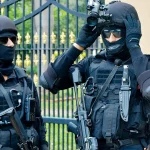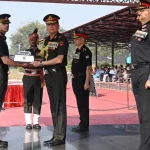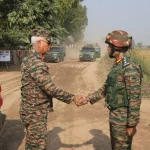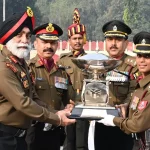The Indian Army, a crucial pillar of national security, is renowned not only for its valor and determination but also for its intricate organizational structure. A foundational element of this structure is the rank system, which encompasses three primary categories: Commissioned Officers, Junior Commissioned Officers (JCOs), and Non-Commissioned Officers (NCOs). Each rank plays a vital role, ensuring operational efficiency, discipline, and a clear chain of command essential for military efficacy. In this comprehensive exploration, we will navigate through the ranks of the Indian Army, their respective insignia, responsibilities, and the significance of understanding this hierarchy for aspiring military professionals.
Historical Context
The structure of the Indian Army and its rank system has evolved significantly over centuries. Post-Independence, the need for a robust and organized military became paramount, leading to the formal establishment of ranks and a comprehensive system which mirrored that of several leading military forces around the globe. The rank system not only reflects the hierarchy within the army but also helps maintain discipline and order, integral to military operations. Over time, each rank evolved, expanding its boundaries and responsibilities to adapt to the changing nature of warfare and defense strategies.
Understanding the Ranks of the Indian Army
Commissioned Officers
Commissioned Officers are the backbone of military leadership. They are entrusted with critical decision-making responsibilities and strategic command. Each rank is characterized by distinct duties and leadership roles, often requiring a substantial amount of training and education.
- Field Marshal
- Description: The highest rank in the Indian Army, awarded typically in recognition of extraordinary service.
- Significance: This rank is rarely bestowed, typically held by only a few, and symbolizes unparalleled contributions to military strategy and national service.
- General
- Description: The highest active rank, responsible for leading the Indian Army.
- Responsibilities: Formulates and implements military strategy, oversees operations across all divisions.
- Lieutenant General
- Description: Oversees corps and large formations; typically, the third-highest rank.
- Roles: Engages in high-level decision-making, often involved in national defense discussions.
- Major General
- Role: Commands divisions and executes critical operations.
- Responsibilities: Tactical planning and execution of strategies across larger geographical regions.
- Brigadier
- Description: Commands brigades; a vital part of the operational command structure.
- Responsibilities: Manages resources and personnel effectively.
- Colonel
- Role: Commands battalions and regiments; ensures discipline and efficiency within units.
- Significance: Directly influences the training and operational readiness of soldiers.
- Lieutenant Colonel
- Description: Functions as an executive officer within battalions.
- Duties: Oversees operational tasking and the implementation of commands issued by higher ranks.
- Major
- Role: Typically leads a company or smaller units.
- Responsibilities: Works closely with junior officers and enlisted personnel.
- Captain
- Description: In charge of platoons, responsible for direct leadership.
- Duties: Immediate decision-maker at the tactical level.
- Lieutenant
- Role: Serves as a junior officer, often in command of small teams.
- Responsibilities: Implements commands and direct leadership, crucial for building operational readiness.
Junior Commissioned Officers (JCOs)
JCOs serve as the crucial bridge between Commissioned Officers and NCOs, playing a significant role in leadership and technical expertise within the ranks. Their presence ensures effective communication and operational execution.
- Subedar Major
- Insignia: Features a gold national emblem with a stripe.
- Role: Senior-most JCO, helps in administration and liaising between ranks.
- Subedar
- Insignia: Displays two gold stars in a row with a stripe.
- Duties: Commands sections or squadrons, instilling discipline and ensuring effectiveness within troops.
- Naib Subedar
- Insignia: One gold star with a stripe.
- Responsibilities: Assists in troop management and supports the Subedar Major, increasingly significant in nurturing junior ranks.
Non-Commissioned Officers (NCOs)
NCOs form the backbone of the Indian Army, responsible for training and discipline, ensuring that soldiers adhere to the standards required for operational effectiveness.
- Havildar
- Insignia: Three chevrons.
- Role: Leads a section, responsible for training and the management of soldiers.
- Naik
- Insignia: Two chevrons.
- Responsibilities: Supervises squads and assists in training junior soldiers, pivotal in maintaining unit cohesion.
- Lance Naik
- Insignia: One chevron.
- Role: A junior leadership position, assisting higher ranks and ensuring discipline.
- Sepoy
- Insignia: No insignia.
- Role: The frontline soldier executing orders during operations, foundational to the army’s operational capacity.
Key Facts and Figures
- Number of Ranks: The Indian Army consists of 17 distinct ranks spread across the three categories of Commissioned Officers, JCOs, and NCOs.
- Selection Process: The promotion to JCO ranks relies on merit and seniority, often selecting qualified candidates from senior NCOs, ensuring that only the most capable leaders ascend the ranks.
- Responsibilities: Each rank serves specialized roles, from frontline duties executed by Sepoys to strategic planning executed by Generals.
- Insignia: The insignia worn by soldiers serves as a badge of honor, denoting experience, rank, and authority, thus establishing a clear hierarchy.
The Importance of Understanding Indian Army Ranks
For individuals aspiring to join the Indian Army, understanding its rank structure is crucial. It not only aids in navigation through military education and training but also prepares candidates for the responsibilities they will shoulder. Knowledge of the ranks is essential for various competitive exams, such as those conducted by SSBCrack and SSBCrackExams, which offer resources like books and online courses tailored for aspirants.
Real-world Applications of the Rank Structure
Understanding the rank structure has practical implications in terms of career progression and engagement with superiors. The hierarchical nature ensures that responsibilities are clearly defined and that there is a path for advancement based on merit and performance.
- Promotion: Aspiring soldiers must engage with the rank hierarchy to understand the pathways available for their advancement.
- Leadership Development: By understanding the roles associated with each rank, aspiring officers can develop leadership skills pertinent to their future roles.
- Operational Efficiency: Recognizing the rank structure enhances teamwork and operational coordination, leading to greater effectiveness in military missions.
Challenges and Solutions
One of the key challenges faced by candidates is misunderstanding or underestimating the significance of ranks. This can lead to confusion during training or operational command. Solutions include:
- Enhanced Training Programs: Strengthening educational programs that emphasize the understanding of ranks and their responsibilities can ensure aspirants are well-prepared.
- Mentorship Programs: Developing mentorship systems where experienced officers guide juniors can demystify the rank structure and foster leadership values.
Future Trends and Predictions
As the nature of warfare and military operations continues to evolve, the rank structure may also see adjustments. Emerging technologies and new strategies of warfare could lead to shifts in responsibility and oversight among ranks, striving for more agile and responsive military frameworks.
- Increased Technological Integration: The introduction of sophisticated technology may redefine roles within the ranks, placing a greater emphasis on tech-savvy abilities.
- Diversity and Inclusivity: As the Indian Army aims to enhance inclusivity, modifications in ranks and gender roles may become essential to align with modern military demands.
Conclusion
In conclusion, the rank structure of the Indian Army is a vital component that reflects the values of discipline, responsibility, and leadership. Each rank serves a specific function, contributing to the overall efficacy and operational readiness of the military. For individuals looking to embark on a career in the Indian Army, comprehending these ranks and their corresponding responsibilities is not merely an academic exercise but a crucial step towards achieving success in military service. Organizations like SSBCrack and SSBCrackExams provide invaluable resources, paving the way for future leaders in the Indian Army. Understanding the intricacies of army ranks can empower aspirants, enhance operational efficiency, and ultimately fortify national security. By fostering a deeper understanding of this structure, candidates can better prepare for their roles as the custodians of India’s sovereignty and integrity.












